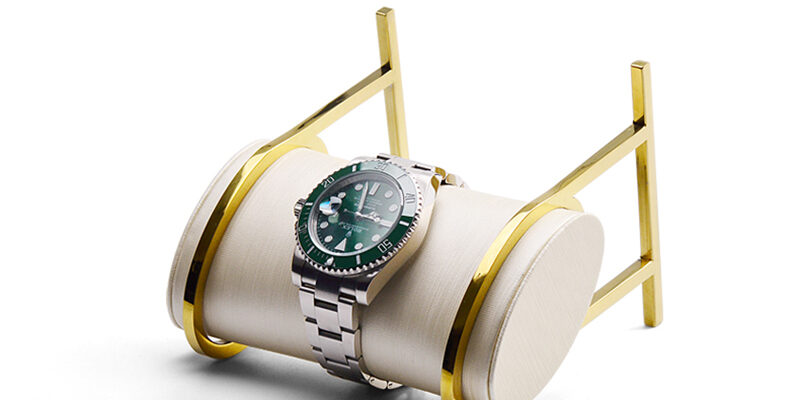Last Updated on 2 years by soonxindisplay
The surface processing of stainless steel is done through different processing methods so that the surface of stainless steel has additional luster, color, pattern, etc., to improve the appearance of stainless steel to achieve an aesthetic effect.
Several stainless steel finishing options alter more than just the appearance of the material. Whatever the intended use, choosing the right finish option is essential.
In projects where the design is a primary consideration, an attractive finish will enhance the appeal of the end product. For example, different finishes can be used in architecture and the automotive industries to achieve various visual effects in retail products, particularly kitchen appliances and display fixtures.
The choice of surface finish is also essential for application fabrication processes. Rough surface finishes are appropriate when the steel will be ground before painting and gluing. Smooth surface finishes are better where the steel will be blended.
The choice of finish should always be specified and defined adequately by standard industry designations.
From a design point of view, it is necessary to understand the following seven stainless steel surface treatment processes.
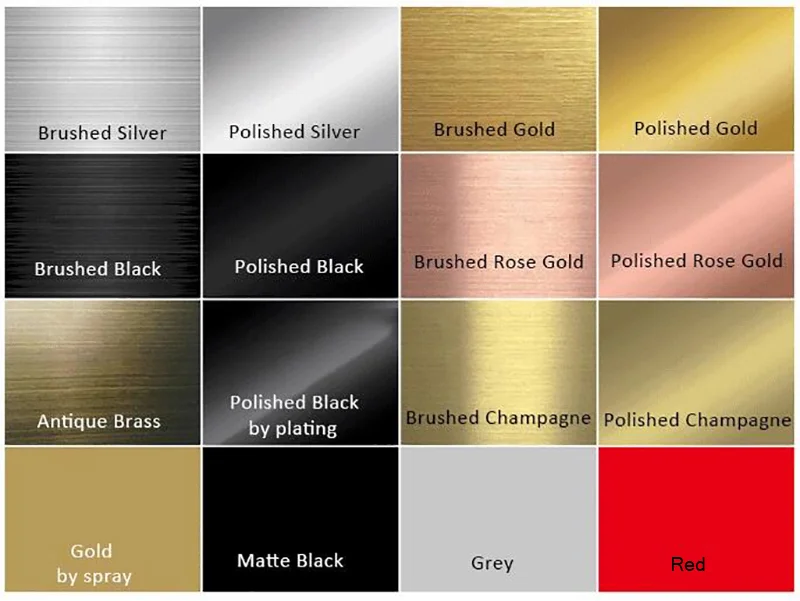

CONTENTS
PVD Process
The surface treatment process for stainless steel materials is mainstreamed in PVD (Physical Vapor Deposition) technology. The metal surface can be coated with a decorative coating with high hard plating and wear resistance through “sandblasting, wire-pulling or polishing and PVD.”
PVD technology is a high-tech and widely used ion coating technology in the world; it has the characteristics of uniform coating, strong adhesion, good plating, fast deposition speed, low processing temperature, comprehensive plating materials, and so on. Its role is to make some particles with unique properties (high strength, wear resistance, heat dissipation, corrosion resistance, etc.) sprayed on the lower performance of the mother so that the mother has better performance.
The selection of the PVD process for the selection of nano-injection molding parts put forward new requirements: vacuum plating method, for example, in a high vacuum for metal heating, melting, evaporation, cooling in the sample surface to form a metal film method, to obtain a mirror-like surface, high-end decorative materials selection, with gorgeous effect, after PVD coating coloring treatment of 304 stainless steel materials have long been used in the field of decoration, widely used in elevators, buildings, and other decorative projects.
The smooth mass production of the iPhone X stainless steel plus PVD process marks the maturity of the stainless steel plus plastic frame PVD technology solution, adding an option for the surface treatment solution for mobile phone manufacturers.
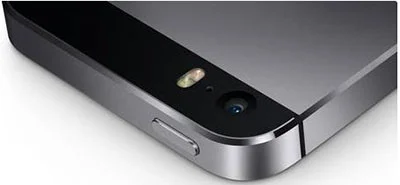

Sandblasting Treatment
Sandblasting is the use of compressed air as the power to form a high-speed injection beam that will spray (copper ore, quartz sand, gold sand, iron sand, sea sand) high-speed injection to the surface of the workpiece to be treated so that the consistency or shape of the workpiece changes. Sandblasting has vital applications in engineering and surface technology, such as: improving the viscosity of adhesives, de-fouling, optimizing machined surface burrs, and surface matte treatment.
Colored stainless steel blasting plate not only retains the excellent mechanical performance and corrosion resistance of stainless steel blasting plate but also has a rich and colorful beautiful color, for the color stainless steel blasting plate adds a pleasing aesthetic, while the color stainless steel blasting plate also has better than the substrate corrosion resistance and other properties, so it will be widely used in modern social life and various fields of the national economy. A colored stainless steel blasting plate is a new environmental protection material.
The blasting process is more uniform and efficient than hand-polished, and the stainless steel treatment of this method creates a low-key, durable product feature.
- Chemical plant equipment
- Pharmaceutical equipment
- Store Fixtures
- Laundry and dry cleaning
- Refrigeration
- Sewage equipment
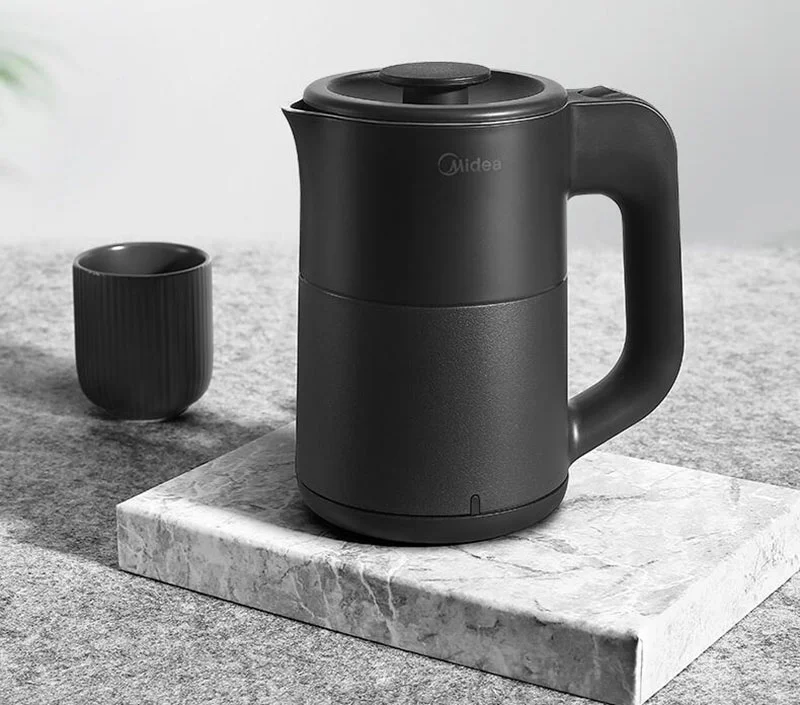

Electroplating
Electroplating technology has been edited in various production and scientific fields of the national economy. Especially in machine manufacturing, defense, telecommunications, transportation, light industry, and other industries have become indispensable. In industrial production, electroplating pipe sails improve the wear and corrosion resistance of various shaft classes, sets, and other components. The method of electroplating is adopted.
ElectroplatingIt involves using an electric current to cause a thin layer of metal to deposit onto the surface of a substrate. In electroplating, you attach the plating metal to the anode, the positively charged electrode of an electrical circuit. You also connect the substrate to the cathode, the negatively charged electrode. You then submerge the plating metal and substrate in a specially developed electrolytic solution called a plating bath.
Once the parts are immersed in the plating bath, you supply an electric current to the anode. This current oxidizes the metal atoms of the plating metal and dissolves them into the electrolytic solution. The dissolved metal ions are reduced at the cathode and deposited onto the substrate. You can adjust the outcome of the process by adjusting factors such as the bath’s chemical composition, the tub’s temperature, the current’s voltage level, the length of time you apply the wind, and the distance between the anode and cathode.
Cover the stainless steel surface with a coating that is resistant to wear or abrasiveness, and corrosion to improve the surface properties of stainless steel. For the covering layer to be firmly integrated with the metal substitute, the surface can be pre-treated in different ways to remove the oil and rust from the surface.
The advantage of electroplating is that it has little effect on the microscopic tissue of the substrate material, and what types of metals can be used for stainless steel plating? Some leading options are copper, palladium, zinc, nickel, gold, and platinum. They are used primarily as works of art and decoration. At SOONXIN, most wallet stands are made from copper stainless steel, with colors like the one below, widely used for elegant and luxury fashion risers.
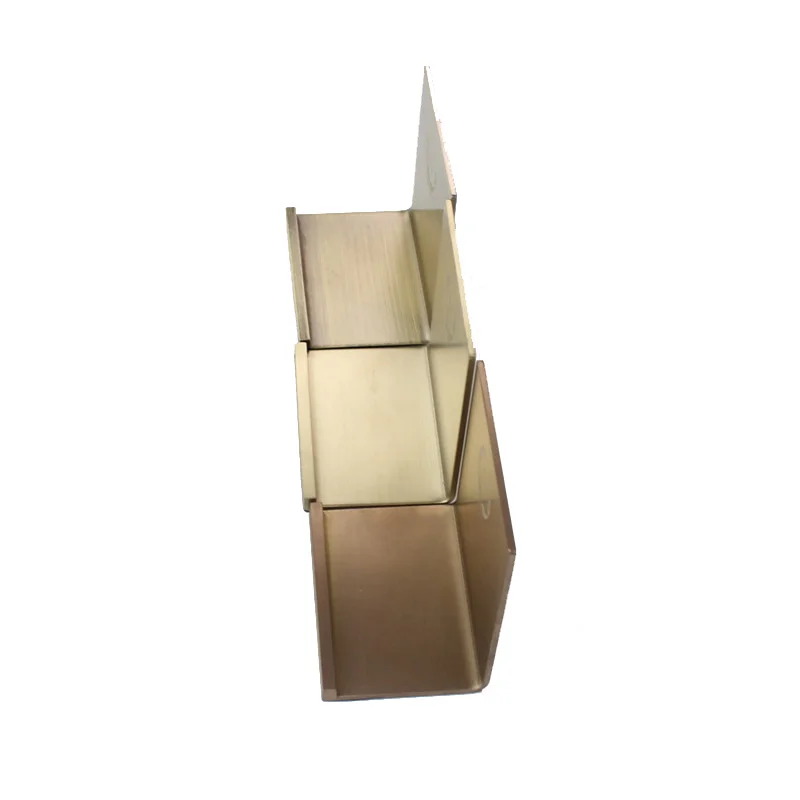

Mirror Finishes
The Mirror finish is highly reflective and created by polishing the stainless steel. The polishing process enhances appearance and consistency, making cleaning easier. It also masks the after-effects of welding and hides surface damage.
The non-directional polishing used to create the mirror-polished finish of Super Mirror 8 is one of the expert techniques that Steel Color uses to make its high-quality products. As a result of this polishing, the stainless steel has a highly reflective surface. This gives it a modern, clean, fresh look that fits with modern architectural design. The mirror-polished stainless steel that Steel Color produces is ideal for design features inside and outside structures created by current architects and construction experts.
At SOONXIN, our mirror stainless steel applications are frequently used in fashion footwear risers and bag display racks. Mirror effect with electroplating colors, making the shop display better luxury and elegance. Highlights the merchandise increases store sales at the same time.


Stainless Steel Coloring
Coloring not only gives stainless steel products a variety of colors, increase the variety of color products, and improves product wear and corrosion resistance. There are many methods of surface coloring; the system is divided into 1, the chemical oxidation coloring method, 2, the electrochemical oxidation coloring method, 3, the ion deposition oxide coloring method, 4, the high-temperature oxidation coloring method, and 5, the gas-phase lysing coloring method—this kind of material is used in many other fields besides building exterior walls and window frame decoration.
For example, a black stainless steel plate can make a solar heat-collecting plate with a heat absorption rate of 91% to 93%. In the arts and crafts industry, the color of stainless steel and printing combined can be etched with the grinding and dot method to match the process to produce never fade three-dimensional relief murals, hanging screens, and so on. Besides using colored stainless steel for manufacturing household appliances, cooking utensils, kitchen equipment, toilet utensils, and fixture equipment will be loved by consumers.
Now the color stainless steel plate colorful, is an excellent decorative material, with it decorated with rich and luxurious quality, color stainless steel plate the same time with strong corrosion resistance, high mechanical performance, and color surface layer lasting non-fading.
Color with light Different light angles will produce color changes and other characteristics; color stainless steel plate and the color surface can withstand 200 degrees C temperature, salt spray corrosion performance is better than the general stainless steel, color stainless steel plate wear resistance, and importing performance is equivalent to the version of foil coating gold. Colored stainless steel plate, when bent 90 degrees C, the color layer will not be damaged; it can be used as hall wall panels, ceilings, elevator panels, car box boards, building decoration, signboards, and other decorative purposes, color stainless steel plates are generally used in decorative walls.
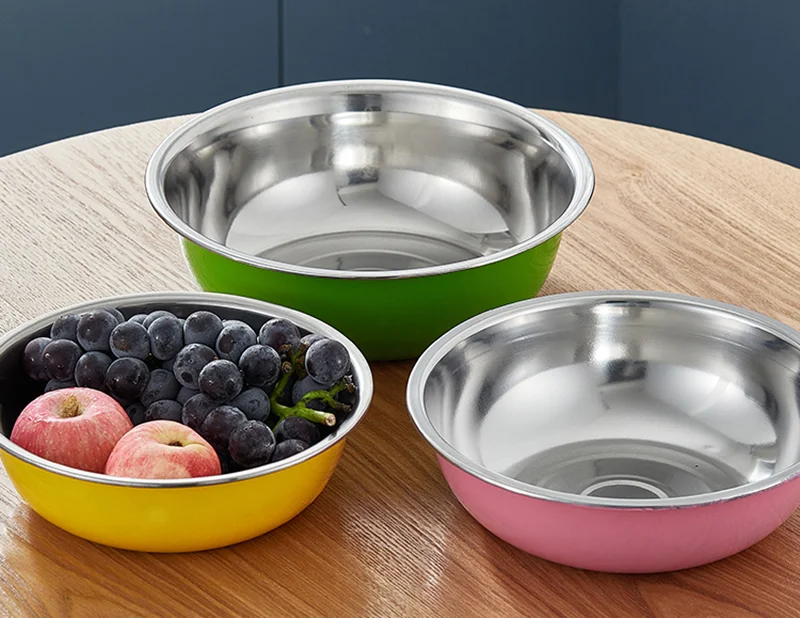

Brushed Finish
The brushed finish process is a commonly used method of stainless steel products, according to the needs of decoration, to make straight, garbled, threaded, rippled and swirling, and so on. Stainless steel surface wire gives an excellent feel, delicate gloss, wear-resistant surface, and personality texture effect. Electronic equipment, kitchen appliances, machinery, and equipment have been widely used.
The Brushed finish can vary with different suppliers and even from batch to batch from the same supplier. The variations arise from differing manufacturing conditions, such as wearing the abrasive belts used in these finishes.
Brushing steel produces a distinctive look with a muted luster and a pattern of fine parallel lines. It has solid decorative appeal without being too reflective, as too much reflectiveness can be undesirable. For example, overly reflective stainless steel accents on a building could be blinding in bright sunlight. The drawbacks to this finish include reduced corrosion resistance because the finish grooves are susceptible to rust.
Spray Process
Stainless steel spraying is substantially different from the coloring mentioned above; depending on the material, some paint may damage the stainless steel surface oxidation layer. However, spraying can use a simple process to achieve different colors of stainless steel products and other spray paint to change the feel of it. Like our daily use, stainless steel cups and display racks are sprayed.
Because the coating relative to plating and other process costs are slightly lower, so in some iron shelves, SOONXIN is more the use of coloring effects, such as floor-to-ceiling racks such as store shelves, larger volume, the use of other processes or stainless steel plating is relatively expensive circumstances, choose coloring effect, reduce costs at the same time, but also make the shelf is not so bulky, flexible. To learn more about the Stainless Steel Shelf Process and Fixture, please visit our web at HERE. Most enormous floor racks are made from metal and sprayed or Coated. The color matches your style and customizes your brand display.



